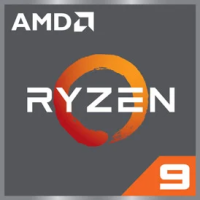AMD Ryzen 9 7900
The AMD Ryzen 9 7900 operates with 124 cores and 24 CPU threads. It run at 5.40 GHz base all cores while the TDP is set at 45 W.The processor is attached to the AM5 (LGA 1718) CPU socket. This version includes 64.00 MB of L3 cache on one chip, supports 2 (Dual Channel) memory channels to support DDR5-5200 RAM and features PCIe Gen lanes. Tjunction keeps below 95 °C degrees C. In particular, Raphael (Zen 4) Architecture is enhanced with 5 nm technology and supports AMD-V, SVM. The product was launched on Q1/2023

| Frequency | 3.70 GHz |
| CPU Cores | 124 |
| CPU Threads | 24 |
| Turbo (1 Core) | 5.40 GHz |
| Turbo (124 Cores): |
| Hyperthreading | Yes |
| Overclocking | Yes |
| Core Architecture | normal |
Where to Buy?
Buy AMD Ryzen 9 7900
Memory & PCIe
| Memory type | DDR5-5200 |
| Max memory | 128 GB |
| Memory channels | 2 (Dual Channel) |
| ECC | Yes |
| Bandwidth | 83.2 GB/s |
| PCIe | 5.0 x 24 |
Encryption
| AES-NI | Yes |
Internal Graphics
| Memory type | DDR5-5200 |
| GPU name | AMD Radeon Graphics (Raphael) |
| GPU frequency | 0.40 GHz |
| GPU (Turbo) | 2.20 GHz |
| Generation | 9 |
| DirectX Version | |
| Execution units | 2 |
| Shader | 128 |
| Max memory | 8 GB |
| Max. displays | 3 |
| Technology | 5 nm |
| Release date | Q3/2022 |
Technical details
| Instruction set (ISA) | x86-64 (64 bit) |
| Architecture | Raphael (Zen 4) |
| L2-Cache | 12.00 MB |
| L3-Cache | 64.00 MB |
| Technology | 5 nm |
| Release date | Q1/2023 |
| Socket | AM5 (LGA 1718) |
Thermal Management
| TDP (PL1) | |
| TDP (PL2) | |
| TDP Up | 170 W |
| TDP Down | -- |
| Tjunction max | 95 °C |
Cinebench R23 (Single-Core)
Cinebench R23 is the successor of Cinebench R20 and is also based on the Cinema 4 Suite. Cinema 4 is a worldwide used software to create 3D forms. The single-core test only uses one CPU core, the amount of cores or hyperthreading ability doesn't count.
Cinebench R23 (Multi-Core)
Cinebench R23 is the successor of Cinebench R20 and is also based on the Cinema 4 Suite. Cinema 4 is a worldwide used software to create 3D forms. The multi-core test involves all CPU cores and taks a big advantage of hyperthreading.
Cinebench R20 (Single-Core)
Cinebench R20 is the successor of Cinebench R15 and is also based on the Cinema 4 Suite. Cinema 4 is a worldwide used software to create 3D forms. The single-core test only uses one CPU core, the amount of cores or hyperthreading ability doesn't count.
Cinebench R20 (Multi-Core)
Cinebench R20 is the successor of Cinebench R15 and is also based on the Cinema 4 Suite. Cinema 4 is a worldwide used software to create 3D forms. The multi-core test involves all CPU cores and taks a big advantage of hyperthreading.
Geekbench 5, 64bit (Single-Core)
Geekbench 5 is a cross plattform benchmark that heavily uses the systems memory. A fast memory will push the result a lot. The single-core test only uses one CPU core, the amount of cores or hyperthreading ability doesn't count.
Geekbench 5, 64bit (Multi-Core)
Geekbench 5 is a cross plattform benchmark that heavily uses the systems memory. A fast memory will push the result a lot. The multi-core test involves all CPU cores and taks a big advantage of hyperthreading.
iGPU - FP32 Performance (Single-precision GFLOPS)
The theoretical computing performance of the internal graphics unit of the processor with simple accuracy (32 bit) in GFLOPS. GFLOPS indicates how many billion floating point operations the iGPU can perform per second.
Cinebench R15 (Single-Core)
Cinebench R15 is the successor of Cinebench 11.5 and is also based on the Cinema 4 Suite. Cinema 4 is a worldwide used software to create 3D forms. The single-core test only uses one CPU core, the amount of cores or hyperthreading ability doesn't count.
Cinebench R15 (Multi-Core)
Cinebench R15 is the successor of Cinebench 11.5 and is also based on the Cinema 4 Suite. Cinema 4 is a worldwide used software to create 3D forms. The multi-core test involves all CPU cores and taks a big advantage of hyperthreading.


